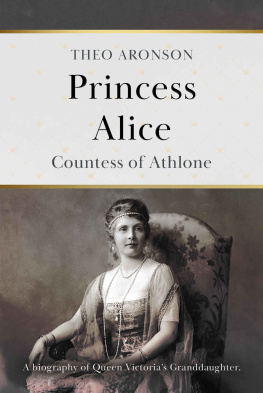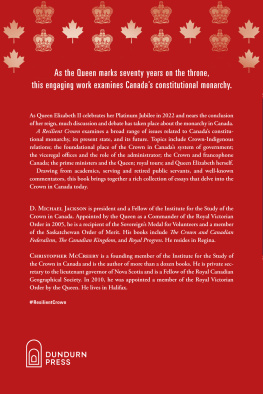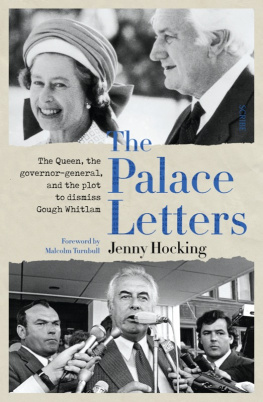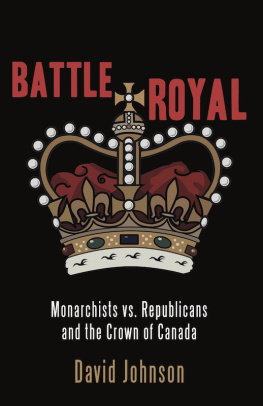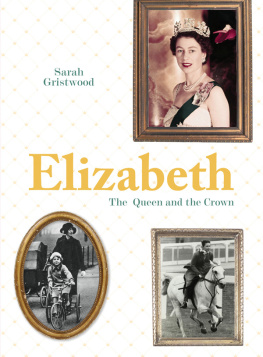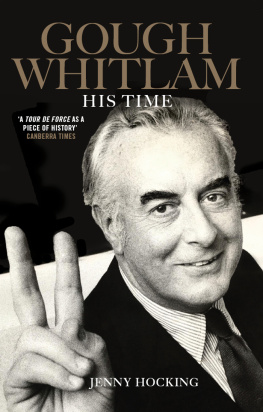Contents
Guide
Page List
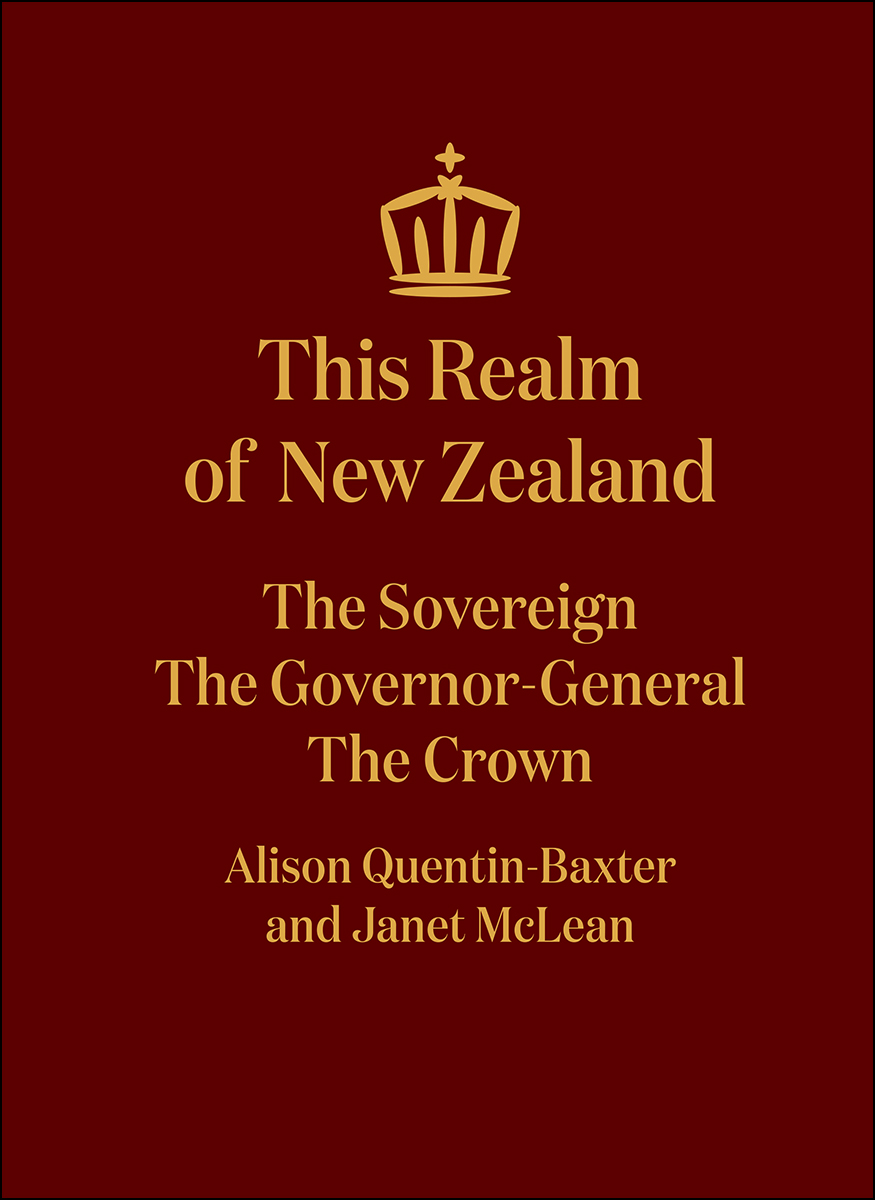
This Realm of New Zealand is an excellent, historically based account of the roles and responsibilities of the Queen in Right of New Zealand and her Governors-General in our present day constitutional monarchy. The authors also put forward carefully formulated proposals that give full weight to the essentially democratic nature of New Zealands constitution, the balance between law and convention, and the virtues of flexibility to enable future development. SIR KENNETH KEITH
New Zealand is a democratic constitutional monarchy, one of Queen Elizabeth IIs sixteen realms. This book provides a comprehensive account of how the Queen, the Governor-General and the Crown interact with our democratically elected leaders under New Zealands unwritten constitution.
The authors explain how these islands in the South Pacific were first brought within Queen Victorias dominions, the arrangements then made for their future government, and how those arrangements developed over time with the pressure for democracy and responsible government to become New Zealands current constitution. They discuss the responsibilities of, and interactions between, the key office-holders: the Sovereign herself; her representative, the Governor-General; the impersonal and perpetual Crown; and the Prime Minister, other Ministers and Members of Parliament. All of them affect in some way the government which runs the country day-to-day. In an afterword, the authors examine some of the key issues to be considered should New Zealand become a republic.
The parliamentary democracy that we take for granted can conceal New Zealands ultimate constitutional underpinnings in the monarchy. But, as the authors make clear, the Sovereign still delegates the authority to govern to the peoples elected representatives. And understanding the roles of the Queen, the Governor-General and the Crown will be critical as we look forward to debates about the possibility of a republic in New Zealand.
DAME ALISON QUENTIN-BAXTER is a distinguished public and international lawyer. She began her career as a member, and later the head, of the Legal Division of what was then the Department of External Affairs, and was a New Zealand representative at a number of conferences on the making or application of international law. Later she was a lecturer in law at Victoria University of Wellington where she taught constitutional history and law. From 198794 she was the director of the New Zealand Law Commission. Dame Alison has acted as a constitutional advisor in New Zealand and other jurisdictions including Niue, Fiji, the Republic of the Marshall Islands, and Saint Helena. She is the author of a report leading to the Sovereigns issue of the 1983 Letters Patent Constituting the Office of Governor-General of New Zealand, Review of the Letters Patent 1917 Constituting the Office of Governor-General of New Zealand (Cabinet Office, 1980), editor of Recognising the Rights of Indigenous Peoples (Institute of Policy Studies, 1998) and she has contributed a number of chapters and articles in books and journals. Dame Alison was appointed a Dame Companion of the New Zealand Order of Merit for services to the law, and is a Companion of the Queens Service Order.
PROFESSOR JANET MCLEAN is a professor of law at the University of Auckland where she teaches constitutional and administrative law. A graduate of Victoria University of Wellington and the University of Michigan, she previously held the position as director of the New Zealand Institute of Public Law at Victoria University of Wellington, and the chair in Law and Governance at the University of Dundee, Scotland. She is the editor of Property and the Constitution (Hart, 1999) and author of Searching for the State in British Legal Thought (Cambridge University Press, 2012) and has contributed numerous articles and chapters in leading books and journals.
This Realm of New Zealand
The Sovereign The Governor-General The Crown
Alison Quentin-Baxter and Janet McLean

In memory of Robert Quentin Quentin-Baxter 19221984
Husband of Alison and a teacher of us both
CONTENTS
ACKNOWLEDGEMENTS
During the long gestation of this project we have incurred a number of debts. We have been greatly assisted throughout the project by the Office of the Prime Minister and Cabinet. Rebecca Kitteridge and Michael Webster, Clerks of the Executive Council, have both provided practical assistance by way of access to files held by the Cabinet Office, as well as friendship and support. The team at the Cabinet Office read parts of the book in draft. We are grateful for permission now to draw freely on the material in the 1980 Report reviewing the Letters Patent 1917, and do so without further acknowledgement, except when quoting its words, or citing it as the source on a particular point. We have also received general guidance from the royal household.
Anna Fleming provided invaluable research of the archival and primary materials. Some of her perceptions are reflected in the book. Sonali Pereras research assistance improved . Without Claire McGeorges careful cite-checking and other research assistance and support we would never have made it across the line. We are grateful to Rt Hon Sir Kenneth Keith, Justice Matthew Palmer, Paul Rishworth QC and other anonymous readers. Dr Dean Knight read the entire manuscript and his generous and detailed comments were of great assistance. Needless to say, none of the readers agreed with everything we have to say. The Law Foundation gave financial support and Lynda Hagen, its director, invaluable moral support. Finally, our heartfelt thanks go to Sam Elworthy and his team at Auckland University Press.
CHAPTER 1
The Purpose of this Book
This royal throne of kings, this scepterd isle,
This precious stone set in the silver sea,
This blessed plot, this earth, this realm,
That is how Shakespeare described the realm of England in the reign of King Richard II. Their equal and independent status gives the Sovereign a direct and personal connection with each of what are now her 16 realms. The United Kingdom remains a realm, but its government no longer has any constitutional role in any of the others.
In this book we tell the New Zealand story: how these islands in the South Pacific were brought within Queen Victorias dominions, the arrangements then made for their future government, and how those arrangements developed to become New Zealands constitution today. We discuss the responsibilities of, and interactions between, the key office-holders: the Sovereign herself; her representative, the Governor-General; the impersonal and perpetual Crown; and the Prime Minister, the other Ministers and all the Members of Parliament. There are others, too, with on-stage roles.
The time is overdue for telling, or retelling, the story of how New Zealands present-day constitution was shaped. There is an urgent need to broaden the understanding of the people who live under it, and to make them better informed about the implications of any proposals for constitutional change. An increasing proportion of New Zealand citizens were born elsewhere: a common British heritage or knowledge of the Treaty of Waitangi cannot be taken for granted. Popular culture tends to confer on members of the royal family a kind of celebrity status. The monarchys place in the workings of the political and constitutional system is largely invisible. Many young people, including those studying law at New Zealand universities, are more familiar with the United States Constitution than their own. The aim of this book is to make the workings of the New Zealand constitutional monarchy more accessible, and to correct some common misunderstandings about how it works.


